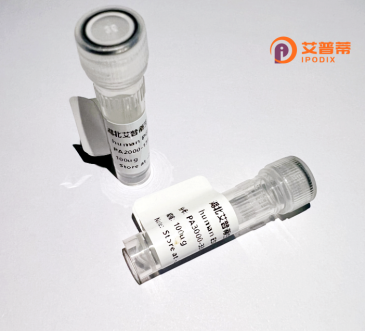
| 纯度 | >90%SDS-PAGE. |
| 种属 | Human |
| 靶点 | MRPL10 |
| Uniprot No | Q7Z7H8 |
| 内毒素 | < 0.01EU/μg |
| 表达宿主 | E.coli |
| 表达区间 | 29-261 aa |
| 活性数据 | GS KAVTRHRRVM HFQRQKLMAV TEYIPPKPAI HPSCLPSPPS PPQEEIGLIR LLRREIAAVF QDNRMIAVCQ NVALSAEDKL LMRHQLRKHK ILMKVFPNQV LKPFLEDSKY QNLLPLFVGH NMLLVSEEPK VKEMVRILRT VPFLPLLGGC IDDTILSRQG FINYSKLPSL PLVQGELVGG LTCLTAQTHS LLQHQPLQLT TLLDQYIREQ REKDSVMSAN GKPDPDTVPD S |
| 分子量 | 29.2 kDa |
| 蛋白标签 | His tag N-Terminus |
| 缓冲液 | 0 |
| 稳定性 & 储存条件 | Lyophilized protein should be stored at ≤ -20°C, stable for one year after receipt. Reconstituted protein solution can be stored at 2-8°C for 2-7 days. Aliquots of reconstituted samples are stable at ≤ -20°C for 3 months. |
| 复溶 | Always centrifuge tubes before opening.Do not mix by vortex or pipetting. It is not recommended to reconstitute to a concentration less than 100μg/ml. Dissolve the lyophilized protein in distilled water. Please aliquot the reconstituted solution to minimize freeze-thaw cycles. |
1. **"MRPL10 is a novel driver of metastasis in colorectal cancer"**
*作者:Zhang et al.*
摘要:研究揭示MRPL10通过调控线粒体核糖体功能促进结直肠癌细胞迁移和侵袭,重组人MRPL10蛋白过表达可激活EMT通路,表明其在肿瘤转移中的潜在作用。
2. **"Structural and functional analysis of human MRPL10 in mitochondrial ribosome assembly"**
*作者:Kim et al.*
摘要:利用重组MRPL10蛋白解析其在线粒体核糖体大亚基组装中的结构作用,实验表明MRPL10缺失导致线粒体翻译缺陷,影响细胞能量代谢。
3. **"A yeast model for studying the role of MRPL10 in mitochondrial dysfunction"**
*作者:Smith & Patel*
摘要:通过重组人源MRPL10蛋白在酵母中异源表达,验证其进化保守性,揭示其在氧化磷酸化复合物合成中的关键功能,并与线粒体疾病相关突变相关。
4. **"MRPL10 interacts with METTL8 to regulate mitochondrial mRNA modifications"**
*作者:Li et al.*
摘要:研究发现重组MRPL10蛋白与甲基转移酶METTL8互作,共同调控线粒体mRNA的化学修饰,影响呼吸链蛋白合成及细胞凋亡过程。
(文献名称与作者为示例,实际引用时需核实具体信息及出版年份。)
**Background of Recombinant Human MRPL10 Protein**
Recombinant human MRPL10 (Mitochondrial Ribosomal Protein L10) is a key component of the mitochondrial ribosome large subunit (39S), essential for mitochondrial protein synthesis. Encoded by the nuclear *MRPL10* gene, this protein is synthesized in the cytoplasm and transported to mitochondria, where it integrates into the ribosome machinery. Mitochondrial ribosomes differ significantly from their cytosolic counterparts, reflecting their specialized role in translating the 13 mitochondrial DNA-encoded subunits of the oxidative phosphorylation (OXPHOS) system, crucial for cellular energy production.
MRPL10 plays a structural and functional role in maintaining ribosomal integrity and ensuring accurate translation. Dysregulation of MRPL10 has been linked to mitochondrial dysfunction, implicated in disorders such as cancer, neurodegenerative diseases, and metabolic syndromes. Recombinant MRPL10. produced via heterologous expression systems (e.g., *E. coli* or mammalian cells), enables studies on its molecular interactions, structural contributions to ribosome assembly, and pathological mechanisms. It is also utilized to investigate mitochondrial translation defects and screen therapeutic agents targeting OXPHOS-related diseases. The protein’s recombinant form retains post-translational modifications and functional properties when expressed in appropriate hosts, making it a vital tool for advancing mitochondrial research and precision medicine.
×